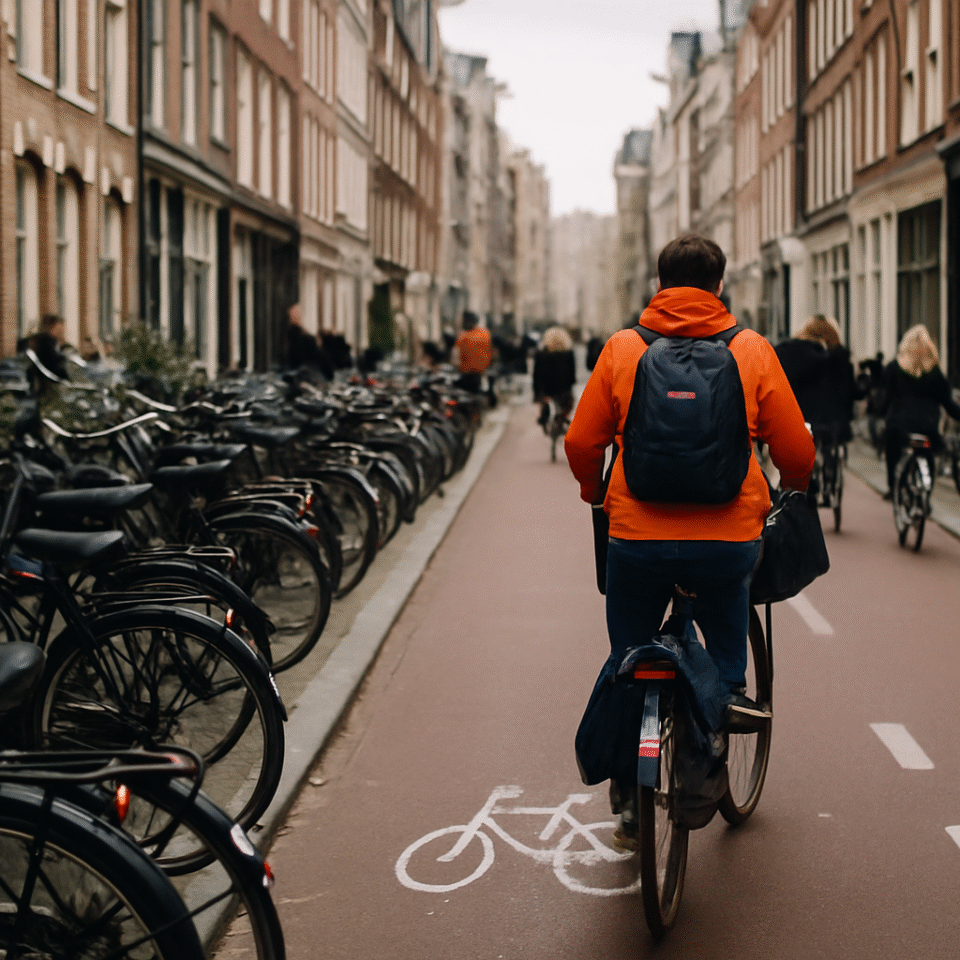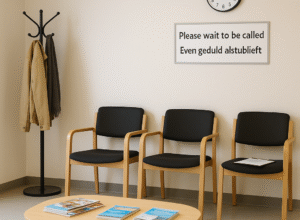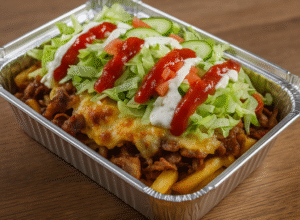Picture this: You’ve just dodged a tram, nearly collided with three cyclists who appeared from nowhere, and you’re standing bewildered at an intersection where bicycles seem to follow an invisible choreography that everyone but you understands. Welcome to your first week navigating Dutch streets, where cycling isn’t just transportation—it’s a cultural cornerstone that reveals volumes about Dutch values, infrastructure priorities, and daily rhythms that differ dramatically from your American hometown.
The Bicycle Nation: Why Cycling Defines Dutch Culture
The Netherlands’ relationship with bicycles goes far beyond convenient transportation. With over 22 million bicycles for a population of 17 million people, cycling represents Dutch pragmatism, egalitarianism, and sustainability values in motion. Unlike America, where cycling is often recreational or the mark of urban hipsters, in the Netherlands, everyone cycles—from toddlers to grandparents, CEOs to students.
This cycling culture developed not by accident but through deliberate policy choices starting in the 1970s, when Dutch citizens protested against increasing car deaths (particularly among children) with the powerful “Stop de Kindermoord” (Stop the Child Murder) movement. The oil crisis of 1973 provided additional momentum, leading to comprehensive infrastructure redesign that prioritized cyclists and pedestrians over cars—the inverse of typical American urban planning.
For American expats, understanding this history helps explain why suggesting “just drive instead” to your Dutch colleagues might earn you bewildered looks. Cycling here isn’t a lifestyle choice; it’s the default transportation mode embedded in national identity.
Cultural Shock on Two Wheels: The American Adjustment
If you’re like most Americans, your cycling experience likely falls into one of three categories: recreational weekend rides, fitness training on expensive road bikes, or nonexistent. The concept of commuting, grocery shopping, or arriving at business meetings via bicycle might seem foreign, even impractical.
The first shock for many American expats is the infrastructure: dedicated bike lanes everywhere, often with their own traffic signals, special bridges, and priority at intersections. The second surprise? The bikes themselves. Forget the carbon-fiber, multi-geared machines popular in America. Dutch bikes are upright, sturdy, often heavy, and deliberately simple—designed for practical transport rather than speed or sport.
Most jarring for Americans is the difference in cycling etiquette. Dutch cyclists rarely wear helmets, frequently use phones while riding, and carry everything from groceries to furniture on their bikes. Traffic laws are followed selectively, creating what initially appears as chaos but actually functions through unwritten rules and shared understanding.
Why Mastering Dutch Cycling Matters for Your Integration
Learning to cycle like the Dutch is about more than transportation—it’s a crucial pathway to cultural integration. Here’s why investing time in cycling acculturation pays dividends:
- Social inclusion: Dutch colleagues routinely plan cycling-based social activities, from weekend countryside rides to cycling to restaurants together after work.
- Cultural respect: Making the effort to adapt to local cycling norms signals your commitment to integration rather than expecting Dutch society to accommodate American preferences.
- Conversational currency: Cycling experiences provide natural conversation starters with Dutch neighbors and colleagues who might otherwise seem reserved.
- Environmental values alignment: Embracing cycling demonstrates respect for Dutch sustainability values, creating connection points with locals who prioritize environmental consciousness.
- Independence: Mastering cycling frees you from dependency on public transport schedules and expensive taxis, expanding your engagement with Dutch cities and countryside.
Essential Dutch Cycling Safety Tips for American Expats
Before you pedal off into the sunset, understanding Dutch cycling safety is paramount for a positive experience:
- Stay visible after dark: Dutch law requires working lights on bicycles at night—white front light and red rear light.
- Use hand signals: While Dutch cyclists may seem casual, signaling turns is essential, especially for beginners.
- Lock properly: Bicycle theft is unfortunately common. Always use two locks—preferably different types—and secure your bike to something immovable.
- Maintain your bike: Regular maintenance ensures safety. Most neighborhoods have affordable bicycle repair shops (fietsenmakers).
- Know the rules: Cyclists must follow traffic signs and signals just like cars, though you’ll notice locals sometimes interpret these creatively.
- Ring your bell: Your bicycle bell is not rude—it’s essential safety equipment for alerting pedestrians and other cyclists.
Practical Steps for American Cycling Acculturation
Start With the Right Bike
Resist the urge to purchase a sporty American-style bicycle. For everyday Dutch cycling, you need:
- An upright “omafiets” (grandma bike) or “opafiets” (grandpa bike) with comfortable sitting position
- Built-in lights and locks (legally required and practically essential)
- Fenders to protect against rain splatter
- Cargo capacity (basket or panniers)
- Minimal gears (the Netherlands is flat!)
Consider buying secondhand initially from markets like Waterlooplein in Amsterdam or through Marktplaats (Dutch Craigslist equivalent). This reduces financial commitment while you adapt.
Learn the Unwritten Rules
Dutch cycling operates on subtle social contracts invisible to newcomers:
- Hand signals indicate turning, but experienced Dutch cyclists communicate intent through subtle body language
- Eye contact establishes right-of-way negotiations at intersections
- Bells are not aggressive—they’re essential communication tools
- Maintain consistent speed rather than accelerating/braking frequently
- Stay to the right except when passing
- Never stop abruptly without checking behind you
Practice in Quieter Areas
Before tackling Amsterdam’s busy Damrak or Rotterdam’s city center, build confidence in residential neighborhoods or smaller cities like Delft or Haarlem, where traffic moves more slowly and patterns are easier to observe.
Join Group Rides
Many municipalities and expat organizations offer guided cycling tours designed specifically for newcomers. These provide safe practice with knowledgeable guides who explain cultural nuances while building your confidence.
Common Mistakes American Expats Make on Dutch Bikes
Even well-intentioned expats make predictable errors when adapting to Dutch cycling culture:
- Over-dressing: Dutch people cycle in regular clothes, even business attire. Special cycling clothing marks you as an outsider.
- Under-estimating weather: The Dutch saying “We are not made of sugar” means they don’t melt in rain. A good raincoat and waterproof pants are better investments than hoping for perfect weather.
- Wrong bike selection: Buying an expensive, sporty model rather than a practical city bike.
- Helmet hesitation: While helmets are sensible safety equipment (especially for children), be aware they’re rare among Dutch adults and might mark you as a tourist.
- Lane confusion: Accidentally riding in tram lanes or on sidewalks instead of designated cycle paths.
- Assumption of car priority: Unlike America, bikes often have right of way over cars at intersections in the Netherlands.
Beyond Transportation: The Dutch Bicycle as Cultural Lens
As you grow comfortable with daily cycling, you’ll begin noticing how bicycles function as windows into broader Dutch cultural values.
Pragmatism: Dutch cycling culture emphasizes function over form. The straightforward, no-nonsense approach to bicycle design mirrors the direct communication style that often surprises Americans accustomed to more diplomatic conversation.
Social equality: On bike paths, CEOs and service workers ride identical bicycles, dressed similarly in everyday clothes rather than specialized gear. This physical manifestation of Dutch egalitarianism contrasts with America’s more status-conscious transportation choices.
Weather relationship: The Dutch saying “we are not made of sugar” (we won’t melt in rain) is exemplified by cyclists continuing through weather conditions that would send Americans driving. This reveals the Dutch value of perseverance and practical adaptation rather than expecting comfort.
Children’s independence: Dutch children cycle to school independently from young ages, reflecting cultural values around child autonomy that differ markedly from America’s more protective parenting norms.
Resources for American Expats Learning Dutch Cycling
For more comprehensive information on adapting to Dutch cycling culture, these resources prove invaluable:
- Bicycle Dutch: An English-language blog about Dutch cycling infrastructure and culture
- Dutch Cycling Embassy: Official resource on Netherlands cycling policy and design
- I Amsterdam’s Cycling Guide: Practical tips for cycling in the capital city
- Local expat Facebook groups: Search “[City name] expats” to find community knowledge and cycling buddies
- Fietsplan: Information on the Dutch bike purchase tax benefit scheme (if you’re employed in the Netherlands)
Embracing Two-Wheeled Integration
As you navigate your expatriate journey, consider your relationship with cycling as a barometer for your broader cultural adaptation. The day you instinctively reach for your bike keys instead of considering a tram—even in light rain—marks a significant milestone in your integration story.
Remember that like all cultural adaptation, becoming comfortable with Dutch cycling happens gradually. Each wobbly start, each successful navigation of a complex roundabout, each grocery trip completed by bike represents another thread connecting you to your new home.
By embracing the bicycle, you’re not just adopting a transportation method—you’re participating in a cultural tradition that has shaped Dutch society, cities, and mindsets for generations. And isn’t that cultural immersion precisely why you chose the expatriate adventure in the first place?








